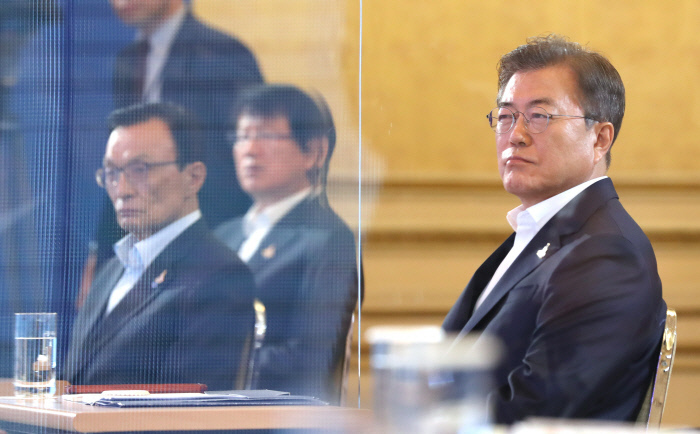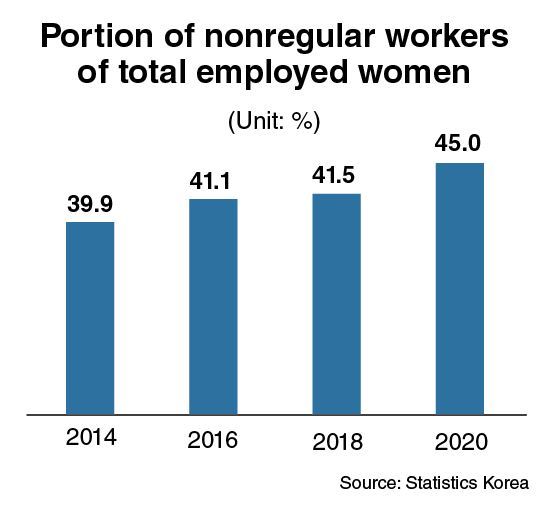[News Focus] 45% of Korean female workers in nonregular job status
Officials argue the surge caused by new ILO standards
By Kim Yon-sePublished : Nov. 29, 2020 - 18:32

SEJONG -- South Korea saw the percentage of those in nonregular job status among the total female workers climb to the all-time high. As for men, the nonregular employee portion marked the highest in more than a decade.
In Korea, job statuses are commonly divided into regular jobs with permanent contracts and consequent protections for workers, and nonregular jobs, such as temporary jobs, contract jobs and other forms of works with low job security.
According to research data on the economically active population by Statistics Korea, 45 percent of all female workers in the nation were in nonregular job positions as of August 2020 -- 4.09 million of 9.08 million women, employed.
The portion was the highest since the nation started compiling the relevant data in 2003. While it was tied with 45 percent in 2019, the previous high was 44 percent, posted in August 2009, when the nation was hit by the global financial crisis.
Korea has published the nonregular job proportion once in a year (for every August figure) since 2017, after unveiling the data twice (for every March and August figures) per annum between 2003 and 2016.

The percentage of nonregular jobs among the total female workers ranged between 39.9 percent and 41.1 percent during the Park Geun-hye administration (February 2013-March 2017). After rising to 41.2 percent in August 2017 under the Moon Jae-in administration, and to 41.5 percent in 2018, it jumped to 45 percent in 2019 and 2020.
The record-low was 39.6 percent in August 2003, when data compiling began.
As for men, the number of nonregular jobs reached 3.33 million of the total 11.36 million male workers, or 29.4 percent in proportion. Like women, the figure for men tied with that of 2019. Both the 2019 and 2020 figures were the highest since March 2008, when the figure posted 30.6 percent.
Collectively for men and women, the percentage of nonregular jobs inched down by 0.1 percentage point to 36.3 percent in 2020 on-year, but this is still quite high compared to the range (31.9-32.8 percent) during the Park administration.
While the figure came to 36.4 percent in August 2019, it was the highest in about 12 years since it peaked at 36.6 percent in March 2007.
Last year, some government officials claimed that the sharp growth in the number of nonregular jobs in 2019 was attributed to re-classification of some regular workers totaling about 350,000-500,000 as nonregular workers.
They argued that the government has applied “a fresh standard,” set by the Switzerland-based International Labor Organization.
But the arguments seemingly lack persuasive power, given that the tally for nonregular employees (both men and women) has increased by 860,000 -- from 6.61 million in 2018 to 7.48 million in 2019. This far exceeds the “re-classification.”
A labor research organization said that the government “has aggressively increased the number of nonregular workers among those in their 60s at state-funded agencies, who are working as cleaning employees.”
In addition, small-sized businesses actively hired those in their 20s in the form of nonregular position contracts in the wake of drastic hikes in statutory minimum wages in 2018 and 2019, he said.
The situation could suggest that the huge allocation of supplementary budgets for job creation during Moon’s term has only created unstable, low-paid jobs for both seniors and young people.
This might have contributed to the overall employment rate. But the Statistics Korea data showed that the portion of stable “regular workers” fell from 67.1 percent in 2017 to 63.7 percent in 2020.
By Kim Yon-se (kys@heraldcorp.com)



![[Exclusive] Korean military set to ban iPhones over 'security' concerns](http://res.heraldm.com/phpwas/restmb_idxmake.php?idx=644&simg=/content/image/2024/04/23/20240423050599_0.jpg&u=20240423183955)

![[Graphic News] 77% of young Koreans still financially dependent](http://res.heraldm.com/phpwas/restmb_idxmake.php?idx=644&simg=/content/image/2024/04/22/20240422050762_0.gif&u=)



![[Pressure points] Leggings in public: Fashion statement or social faux pas?](http://res.heraldm.com/phpwas/restmb_idxmake.php?idx=644&simg=/content/image/2024/04/23/20240423050669_0.jpg&u=)









